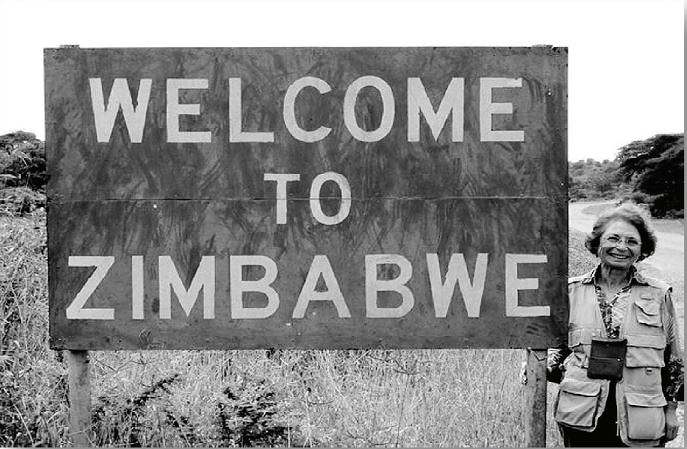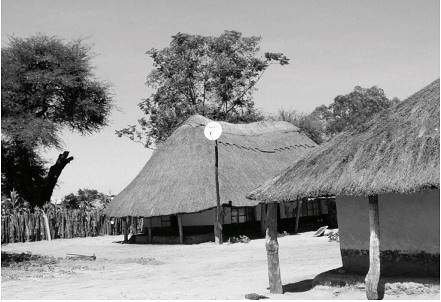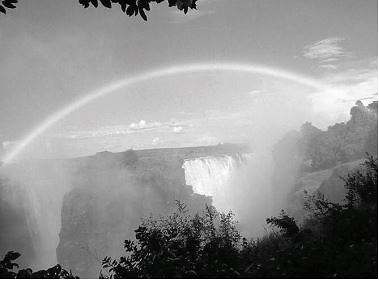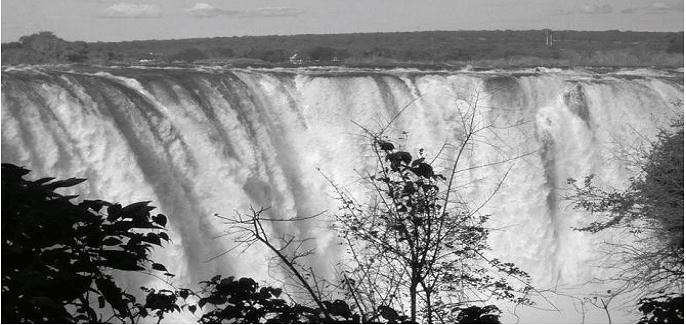
February 2008
On the way from Victoria Falls to Hwange National Park, we flew high to avoid turbulence. Flying in and out of clouds, we could see their shadows cast on the green tapestry below. I felt like a painter with a camera. I could see why this landscape, dotted with huge puddles, inspired the arts and crafts of local people. Local textiles reflected seasonal changes in colors. Batiks simulated the lush foliage of the bush, as well as its parched landscape. Flowers, leaves, and pods inspired basket patterns. Zebra stripes, giraffe spots, and animal horns appeared in myriad forms in a variety of crafts.
A minivan delivered us to our camp in the northeast corner of Hwange, Zimbabwe’s largest game reserve, resting on the edge of the Kalahari sand mass. To make its arid climate a hospitable habitat for wildlife and vegetation, a system of pumps carrying underground water to watering holes had been installed throughout the park. Our tented camp offered a clear view of a watering hole, the broad savannah grasslands,
and acacia woodlands.
My mind drifted to the early inhabitants of these lands, which have been shaped by the unpredictable twists and turns of history. The indigenous Zimbabweans were the hunter-gatherer Bushmen, or San. Between 200 BC and 1000 AD, Bantu agriculturalists and herdsmen migrated south, absorbing and displacing the San. The 9th century saw the arrival of the cattle-herding ancestors of the Shona tribe, who make up 60% of today’s population. The newcomers constructed towering houses of stone as they grew in wealth and power. The word “Zimbabwe” means “House of Stone.” Fleeing from Boer voortrekkers, the Ndebele, now the second largest language group, settled in the west of Zimbabwe in the first half of the 19th century.
Meanwhile Portuguese explorers, English missionaries, ivory hunters, and gold miners arrived in search of wealth. In 1893 the Shona and Ndebele, traditional enemies, joined forces to drive out the Europeans. Under fire power many of the settlers were killed, and Zimbabwe was ruled by and for the British for 85 years. Britain named the country “Rhodesia” after Cecil John Rhodes, who made a fortune in diamonds in South Africa, and extended British influence from Cape Town to Cairo.
In 1957 the Southern Rhodesian African National Congress emerged to free the country from European colonial powers. In 1963 the nationalist movement split into the Zimbabwe African National Union (ZANU) and the Zimbabwe African Peoples’ Union (ZAPU). A furious rivalry developed. Whites pressed the British government to give Rhodesia independence. Ian Smith, a farmer, became prime minister of Southern Rhodesia in 1964 and secured independence in 1965.
Shona and Ndebele guerilla forces organized in 1966 and began Maoist-style rural infiltration. In the mid-1970s Smith tried to reach out to the two liberation groups. But they were not interested; instead, they joined forces as the Patriotic Front, leading to an all‑party conference and a cooperation agreement signed in London in 1979. Elections followed in 1980, and Robert Mugabe became Zimbabwe’s first Prime Minister.
Zimbabwe was Africa’s 50th state to gain independence, but at a high cost. In total 27,000 people died, and two thirds of the population left. Although Mugabe assured the nation that there was room in Zimbabwe for both winners and losers, the white commercial farmers who stayed have all lost their farms. Since they were the economic backbone of the country, turning their farms over to unskilled labor has led to a scarcity of goods and extreme poverty. Mugabe is still at the helm, but leads the country with no tolerance for opposition; he responds with violence to any challenge to his authority or worldview.
Our camp did not reflect the country’s scarcity of goods, as all our food was imported by private concessions. During our first game drive we saw elephants, zebras, elands, and buffalo. An unusual treat was the sight of giraffes with their legs extended on both sides so they could crouch to drink from a watering hole. While their long necks and legs make it easy to eat treetop foliage, they present a challenge for drinking. As we neared the river to watch the sunset, tree silhouettes reflected in the water were a spectacle to behold. This was a wonderful setting for a birthday drink, yet so different from where I had been a year earlier, walking through clouds on Machu Picchu. We returned to camp for a delicious dinner — fruit salad in amaretto, followed by steak, roast potatoes, pasta, and creamed spinach; birthday cake for dessert was enjoyed by all.
The following morning, our intended nature walk turned instead into a rhino chase after our guide spotted tracks. Donning his gun and ammunition belt, he scattered powder in the air to determine the direction of the wind. We had to walk in the opposite direction of the wind, so that the rhinos would not smell us. They have a strong sense of smell and hear well by constantly moving their ears like antennae. We tiptoed into the bush until we saw two rhinos, a male and a female, at a distance. Unfortunately, they sensed us and moved away.
Back at camp, we had a lecture providing us with information on the park, which is named after chief Hwange of the San tribe. In recent years, army guards from Zambia have come to hunt rhinos for their horns. In response, the park has been declared an Intensive Protective Zone and is monitored by guards. Because of the scarcity of rhinos, killing one in Zimbabwe carries a fifteen-year jail sentence. The elephant population presents a different challenge; their numbers far exceed the park’s capacity of 15,000. The elephants are periodically culled, because they stunt the trees and destroy the environment. Hwange is considering a plan to join with other parks to expand protection for elephants.
Our school visit provided insights into Zimbabwe’s poverty. After traveling about an hour in our land rovers, we transferred to an oxcart to reach the Ngamo School, which serves a village of 800 people. I had to sit on a straw floor mat in the cart, because the higher sides were reserved for men. The primary school has 226 students, attending first through seventh grades. There are about 35 students per grade. Only eight or nine of the graduates each year will go on to high school, because there is no high school nearby, and sending a child to live and attend school in a town is beyond the means of almost all villagers. Of those who are able to continue through high school, only three or four each year will attend college. Most children stay around the homestead to work and marry.
Children have breakfast at home before going to school, where they arrive at 7 am, some walking as far as four miles. Most do not eat again until they go home at 4 pm. It is not only school that cannot provide them with lunch; their homes lack food as well. Due to excessive rain, many crops have been ruined, depriving villagers of basic foods such as maize, sorghum, millet, and vegetables. Some students are too weak to walk to school, so they stay home. There is no clinic. In case of serious illness or accident, transportation to the nearest facility is by donkey or oxcart; a train runs once a day to Victoria Falls for those who need hospital care. Many die before they are treated.
Children in the fourth and fifth grades sang, danced, and drummed for us in their classrooms. Young boys had amazing dexterity on the drums. They all knew English and wore uniforms, although some were without shoes. We visited the school principal and teachers, all of whom wore neckties. The school lacked any playground equipment; children played tag in groups during recess. The sandy schoolyard was divided by rows of rough white stones, which were used for students to line up by grade before going into class. We left school supplies as gifts, but what these children needed most was food and vitamins. I suggested we skip a meal or two at the camp and donate the food to the school, and was told that Mugabe might shut down the concession if he got wind of such an action.

Headman’s homestead
A short walk down the path brought us to the headman’s homestead, one of 27 in the village. He welcomed us with his wife, stepmother, son, daughter-in-law, and granddaughter. The headman’s immediate family of 19 people expands to 40 during holidays. He received us in the communal kitchen, where we sat on low benches along the perimeter. Women and children sat on a reed mat on the floor. They were from the Mattebelle tribe, a branch of the Zulu, and spoke Cyndebelle. The headman explained some of the tribal traditions. The head of a household gives oxen or money for a bride, who leaves her homestead to move in with her husband’s family. At death, men are buried in the front of the homestead and women in the back. The house of the deceased is torn down to release the spirit. However, traditions are changing as more couples opt for white wedding gowns over tribal dress.
In the evening we were treated to dancing and drumming around a campfire. The staff performed two Zulu dances — a tango and a miners’ dance, which featured percussive footwork, imitating the cleaning of mud from shoes. Displaying individual showmanship, these dances are performed at weddings and funerals, where people dance to a frenzy to help spirits on their journey. We joined in the final communal dance. Our farewell dinner, which began with a stuffed tomato appetizer, continued with a choice of grilled meats, polenta, stuffed acorn squash, baked potato, and cake with custard sauce.
On our final morning we went for a nature walk, which acquainted us with a variety of trees — stinga, vegetable ivory palm, ebony, teak, wild date, and acacia, which is used to make sewing needles. We passed a mud bath that had an elephant’s body print in profile. We learned that elephant dung is used by local people to stop nosebleeds when inhaled, and to ease labor and birth pains when consumed as a hot drink.
After a delicious brunch at camp, we drove to the airstrip and flew to Victoria Falls. During the flight I volunteered to sit next to the pilot, as our group had been taking turns doing so. Sitting for the first time in a cockpit, I expected action; instead, it felt like being in a car on cruise control. During the hour-long flight, I gradually turned my gaze from the radar screen to the lush scenery below and began taking pictures, which I continued upon landing, attracted by bright red flowers, called launa, at the airport.
At the Ilala Lodge, we were welcomed with passion fruit cocktails. While charmed by the shaggy reed roofs, I was ready for the swimming pool and manicured grounds, having just spent two weeks in the bush. After taking some time to unwind, we left for Victoria Falls by minivan. We could hear the cascades thundering from a distance; in fact, the falls’ African name, Mosi-oa Tunya, means “Thundering Smoke.” The Zambezi River, which is straddled by Zimbabwe and Zambia, forms the world’s largest curtain of water at the falls. They are as high as Niagara Falls and 1½ times as wide. At peak flood times 1.4 billion gallons of water per minute pass over the edge.

Rainbow over the falls
The Zambezi River had flooded a month before, so the natural wonder was at its mightiest. A rain slicker I had bought online came in handy for this wet exploration as we moved through the rain forest, in and out of trails and lookout points, each with different views. The rainbow-colored spray rising from the waters as they crashed into the chasm created lovely panoramas, although they were a challenge to photograph while keeping cameras dry. Of the five main cataracts, the Main Falls and the Devil’s Cataract were the most dramatic. Fed by Victoria’s perpetual spray, the flora around was equally beautiful. Lianas, blood lilies, ferns, and orchids, as well as ebony, mahogany, and fig trees shared the forest with birds, butterflies, monkeys, and small buck.
That evening’s buffet dinner on the patio included both familiar and exotic fare. Onion soup and a variety of cold appetizers, including dried tomatoes in balsamic vinegar and crocodile salad, were followed by a choice of main dishes such as roast beef, grilled tilapia, and warthog, accompanied by stir-fried vegetables, roasted potatoes, and pasta. The dessert buffet displayed warm apple cake with sauce, chocolate mousse, and fruit.
Among a variety of optional activities was bungee jumping off the Victoria Falls Bridge. I opted for a helicopter ride over the falls, a tour of the Livingstone Museum across the border in Zambia, and a sunset cruise on the Zambezi River. The helicopter ride, although only twelve minutes long, provided breathtaking views of the great tapestry below — greenish-white water compressed into the gorge, dripping rock faces, billows of spray, rainbows, and jungle all around. Our pilot flew close to the ground so that we could see the water’s journey to the edge over a platform of black basalt, gathering momentum before it cascaded down. As the helicopter circled over the falls, we were able to enjoy a bird’s-eye view of rainbow-colored sunlight penetrating the heavy mist over the gorge and across the lush forest.
Shearwater Adventures, organizers of the optional tours, cancelled our museum tour, because the cost for a Zambian visa had gone up from $10 to $70, an excessive price to pay for a three-hour visit. The museum would have offered anthropological and cultural insights, in addition to full information on Dr. David Livingstone, a legendary figure in African history. Instead I spent the afternoon in the open market, surrounded by a colorful mayhem of vendors pleading to sell something so that they could eat. Bartering or bargaining was expected here. Inflation is more than 100,000%, and a dollar goes a long way. Despite the overwhelming experience of such poverty amidst plentiful kitsch, there were enticing handicrafts — Shona stone and wood carvings, textiles, and basketry. I managed to buy a tablecloth, a few carved items, and a charming folk painting of hippos in the water for my grandchildren’s bedroom.
Our sunset cruise was yet another memorable experience. We spotted crocodiles and hippos in the water, lizards on trees, and vultures in the air. As soon as someone exclaimed “Hippos!” there was a surge toward the rail. “There! Black shapes with lots of foam!” One hippo broke the surface. Cameras clicked away. People took photos of one another. An island, home to a palm grove, poked through the surface of the river. We drifted past a cove with trees growing right to the water’s edge. Other boats arrived to witness the changing colors of the sun as it magically disappeared into the night sky.
Early the next morning we had a lecture by Mr. Washington, who was an authority on David Livingstone, a Scots-born missionary and explorer who lived in Zimbabwe for 37 years during the time of the slave trade. This was a lucrative business for the chiefs who ruled the land. While chiefs in the region conquered each other’s tribes, they also met 70% of the European and 30% of the American demand for slaves. 99% of the people had no rights; women were given almost no choices in life.
Dr. Livingstone came from a poor family, had trained as a physician, and had also studied theology. He was 27 years old when he came to Zimbabwe, and initially lived in a 14×10-foot tenement building. During his many years in southern Africa he set up two missions, one of them in Botswana. He spoke fifteen native African languages and translated the Bible into Setswana. He also recruited volunteers for his expeditions and was welcomed by all tribal chiefs, many of whom he converted to Christianity. At this time Zambia had the most important chief, and became the country with the largest Christian population.
During one of his expeditions Dr. Livingstone came upon the natural wonder of the falls, deeming it to be a scene “gazed upon by the angels in their flight.” He made the falls famous in the Western world, naming them after Queen Victoria in 1855. There is a bronze statue of Dr. Livingstone gazing over the falls. He is glorified as a person who provided inspiration through personal sacrifice. He was mauled by a lion and traveled by oxcart for three months to receive treatment, he was one of the first people to use quinine, and he lost his wife to malaria. Dr. Livingstone was committed to ending the slave trade, a vision which became a reality in 1879, five years after his death. He died of malaria and is buried in Westminster Abbey, though his will later revealed that he had wanted to be buried in Zimbabwe. At deliberations following independence, it was decided to leave his statue in Zimbabwe and his body in Westminster.
During free time after the lecture, I decided to explore. Across from our lodge was a casino, a state-of-the-art building complete with blinking lights and luxury shops, but no customers. A walk through a park of lawns and huge trees led me to the Edwardian railway station, where trains arrive from Cape Town. After a short walk from the station down a tree-lined street, I arrived at the chunky, orange-tiled Victoria Falls Hotel. Built in 1904 and refurbished many times, this luxury hotel had an impressive courtyard, patios, colonnades, huge trees, and views over the falls and bridge. There were very few guests around to enjoy its white-gloved ambience and superb setting.
Victoria Falls Village, half a mile back, was a world apart from the protected parkland of the hotel. A bustling place during good times, the village shops with their quality goods had no customers; but hungry men hung around outside trying to sell trinkets. Avoiding the vendors, I walked into a shop, where I found several people eager to wait on me. I was happy to give them some business. I bought a batik shirt, a beaded necklace, and a small beaded pot. Beadwork is a specialty of the Ndebele tribe. Then I strolled over to the Women’s Craft Market. Women, many HIV-positive, sat behind rows of crowded stalls displaying handmade items — crocheted bedspreads, tablecloths, and batiks of every size and color. They seemed willing to barter for anything. I bought yet another batik cloth from a woman, who clearly did not look well. I knew that the $20 she received from me would buy her some food from Zambia.
On our way to the airport we stopped by the Tip-Top Smiles preschool, owned and run by Mado, our trip leader, and his family. His older sister and wife taught four- and five-year-old children from poor families. They ate at school, with food purchased in Zambia. Mado, who had seen hard times himself, was happy caring for others now. As a boy from the bush, he had not been accepted to any city school, exception for one run by Seventh Day Adventists, where he had met his wife. His training as a car mechanic had led him to a job as safari driver, which had then qualified him to be a guide, thanks to his strong command of English and knowledge of the bush.
As we left for Johannesburg for our extension trip to Cape Town, we hugged Mado goodbye, wishing him and his beloved Zimbabwe good luck with the much anticipated upcoming elections. Although the elections have since been held, the results had not yet been revealed at the time of writing. Mugabe, at the age of 84, is still looked upon by some as a hero of the nation’s struggle against white rule. He has become deeply unpopular, though, as the economy has imploded. He is reluctant to step down, although the opposition party claims victory. There may be run-off elections, which I hope will allow a regime change without violence. Zimbabwe is a beautiful country with much potential to be Africa’s bread basket, thanks to its verdant lands.

Victoria Falls
